#ISO-Pascal
Explore tagged Tumblr posts
Text

The Snail
This image captures the intricate details of a small snail with a translucent body and a beautifully patterned brownish shell. The snail's delicate antennae are extended forward as it crawls on a textured, gray surface, creating a sense of movement and exploration.
The overcast day provided soft, even lighting, akin to having the snail under a large soft box, which helped to highlight the subtle details of the snail's form without harsh shadows.
Using a 100mm macro lens, I was able to achieve an incredibly close and detailed view of the snail, revealing textures and patterns that are usually unnoticed by the naked eye. Macro photography allows for an intimate exploration of small subjects, bringing out their unique characteristics and beauty. The 100mm focal length provided a comfortable working distance, ensuring that I could capture the image without disturbing the snail's natural behavior.
In post-processing, I aimed to enhance the image further. I started by selectively adding contrast to enhance the texture of the snail's shell to bring out its intricate details and patterns. This helped to make the shell's structure more prominent, adding depth to the image. I then used a tilt-shift filter to emphasize the shallow depth of field. This filter helped to keep the snail in sharp focus while gently blurring the background, enhancing the sense of depth and isolating the snail from its surroundings. Finally, I knocked in some shadows on the ground in front of the snail to add dimension and create a more three-dimensional look. These subtle shadows help to ground the snail.
Shot at Les Vergers Villeneuve and Blueberry Farm, Saint-Pascal-Baylon, ON, Canada.
Processed with Affinity Photo v2 and Topaz Photo AI.
Camera: Pentax K-3
Lens: smc Pentax DA FA 1:2.8 100mm Macro
100mm / ƒ/10 / 1/50s / ISO 400
Taken: July 16, 2024
#photographer on tumblr#original photographers#original photography#macro photography#snail#shell#mollusc#texture#canada#ontario#where I live#summer#July#2024#pentax#pentaxian#pentax k3#Affinity Photo#Topaz Photo AI
13 notes
·
View notes
Note
21+ / F! ISO a pedro pascal oc to write against my female oc in a tumblr rp! Really wanting to do something where my character is the babysitter/nanny for his kid(s). If you’re interested like this and I’ll reach out! Thank you so much! 🍀
.
#fc!pedropascal#pedro pascal faceclaim#forced proximity rp#oc rp#roleplay#rp#roleplay search#rp finder#roleplay finder#indie rp#1x1 rp#18+ rp
5 notes
·
View notes
Note
hi! could i request some name/pronoun ideas for a dima kin? i would prefer it if they could be mostly masculine. thanks :)))
names: dima, dim, mitya, demi, corinth, micah, lupus, banquo, catellus, julian, denis, delta, dante, dari, dacno, dalton, pascal, astatine, char, dilemma, siren, amy/amygdala, dusk, migraine
pronouns: he/him, hx/hxm, h?/h?m, it/its, io/ion, iso/isos, ato/atoms, atyp/atyps, asset/assets, dull/dulls, fool/fools, tool/tools, bark/barks, maw/maws, bite/bites
hope these are good!! ^_^
1 note
·
View note
Text
How Mask Testing Labs Test for Breathability and Comfort?
In today’s health-conscious world, masks have become essential gear for personal safety, especially in healthcare, industrial, and everyday environments. While filtration efficiency and protection are paramount, breathability and comfort are equally important factors that determine whether people can wear masks correctly and consistently.
A mask that is difficult to breathe through or uncomfortable to wear will likely lead to improper use or removal, reducing its effectiveness. This is why Mask Testing Lab do not just evaluate masks for their filtration capabilities but also rigorously test them for breathability and wearer comfort.
In this blog, we’ll explore how mask testing labs assess breathability and comfort, the importance of these parameters, and what standards govern these tests to ensure that masks are both safe and user-friendly.
Why Breathability and Comfort Matter in Masks
Masks serve as a physical barrier against airborne particles, bacteria, and viruses. However, if the mask restricts airflow too much, it becomes a struggle to breathe. This discomfort can cause users to:
Frequently adjust or remove the mask
Wear the mask improperly, e.g., below the nose
Avoid wearing masks altogether
Similarly, comfort influences mask compliance, especially during extended use in hospitals, workplaces, or public settings.
Breathability refers to the ease with which air passes through the mask material, while comfort encompasses multiple factors, including mask fit, material softness, moisture control, and skin irritation potential.
How Mask Testing Labs Measure Breathability
Breathability testing is designed to quantify the resistance a mask offers to airflow, often called differential pressure (ΔP) or pressure drop.
1. Differential Pressure Test
What It Is: This test measures the pressure difference across the mask material as air flows through it at a standardized rate, typically measured in pascals (Pa).
How It Works: A sample of the mask material is placed in a sealed test chamber. Air is pushed through the material at a constant flow rate—usually simulating human breathing, such as 8 liters per minute. Sensitive pressure sensors measure the resistance or pressure drop created by the mask.
Interpretation: Lower pressure drop means better breathability. Masks with too high a differential pressure are harder to breathe through and may cause discomfort or fatigue.
Standards: The differential pressure test is standardized under various protocols:
EN 14683 (European standard for medical masks)
ASTM F2100 (American standard for medical masks)
ISO 22609 (mask penetration resistance and breathability)
2. Airflow Resistance Test
What It Is: Similar to the differential pressure test but often focused on respirators like N95 masks, it measures the inhalation and exhalation resistance separately.
How It Works: A mask is mounted on a mannequin head or test fixture, and air is drawn through or pushed out at specified flow rates. Instruments measure the force needed to move air through the mask material.
Interpretation: Lower inhalation and exhalation resistance values correlate with easier breathing. High resistance may cause wearer discomfort, especially during physical activity.
Standards: Tests follow NIOSH 42 CFR Part 84 guidelines for respirators.
How Mask Testing Labs Evaluate Comfort
Comfort testing covers various subjective and objective parameters to ensure that the mask is wearable for long durations without causing discomfort or skin issues.
1. Fit and Seal Testing
Purpose: A mask must fit snugly without gaps but not be so tight as to cause pain or pressure marks.
Methods:
Qualitative Fit Testing: Using agents like saccharin or Bitrex to detect leaks around the mask.
Quantitative Fit Testing: Using instruments (e.g., PortaCount) to measure the exact amount of leakage.
Impact on Comfort: Poor fit causes discomfort and reduces protective efficacy.
2. Material Softness and Skin Compatibility
Material Assessment: Testing labs analyze the softness of the inner mask layers and the absence of irritants.
Skin Sensitivity Tests: Some labs conduct patch tests or dermatological assessments to check for allergic reactions.
Breath Moisture Management: Masks should wick moisture away to prevent sogginess and irritation.
3. Moisture Vapor Transmission Rate (MVTR)
What It Is: MVTR measures how well the mask material allows moisture vapor (sweat, exhaled humidity) to pass through.
How It Works: A sample of mask fabric is sealed over a container of water vapor. The amount of vapor that passes through the material over time is recorded.
Importance: High MVTR values mean the mask remains dry and comfortable, reducing skin irritation and odor.
Standards: ISO 15496 is a common reference for MVTR testing.
4. Thermal Comfort Testing
Objective: To determine how the mask impacts facial temperature and heat build-up.
Method: Specialized chambers simulate environmental conditions while temperature sensors measure heat retention on the skin beneath the mask.
Why It Matters: Masks that trap heat can cause discomfort, sweating, and reduced compliance.
Why Testing Breathability and Comfort Is Essential
Ensuring User Compliance: Masks that are breathable and comfortable encourage users to wear them properly and continuously, maximizing protection.
Supporting Healthcare Professionals: Medical staff often wear masks for long shifts. Comfort testing helps reduce fatigue and skin problems.
Enhancing Product Quality: Manufacturers use lab data to improve designs, materials, and mask construction.
Meeting Regulatory Requirements: Health authorities require breathability standards to be met before masks are approved for sale.
Choosing a Reliable Mask Testing Lab
If you are a manufacturer or buyer, selecting the right Mask Testing Lab for breathability and comfort testing is crucial. Consider the following:
Accreditation: ISO/IEC 17025 accreditation ensures lab competence.
Range of Tests: Confirm the lab offers breathability, fit, skin compatibility, and moisture tests.
Experience: Labs with experience in PPE testing understand regulatory nuances.
Reporting: Detailed, clear test reports help in certification and marketing.
Compliance Knowledge: Labs familiar with EN, ASTM, NIOSH, and ISO standards offer comprehensive validation.
Conclusion
Breathability and comfort are vital factors that determine the practical effectiveness of masks. Without proper breathability, masks can cause discomfort and reduce user compliance, compromising safety. Meanwhile, comfort considerations—such as fit, material softness, moisture management, and thermal regulation—are equally important to ensure prolonged wearability.
Mask Testing Labs play a crucial role in assessing these parameters through advanced, standardized testing methods. By measuring differential pressure, airflow resistance, fit, and comfort factors, these labs help manufacturers produce masks that are both protective and wearable.
0 notes
Text
DOMATAKA MOTOR CORP $46,412,121,462,693,697 100% Founder 100% Business 200% Bank
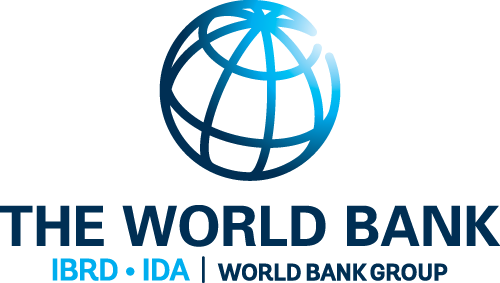
Bank of Japan
Central bank
The Bank of Japan is the central bank of Japan. The bank is often called Nichigin for short. It is headquartered in Nihonbashi, Chūō, Tokyo.
Source: Wikipedia
boj.or.jp
Founder: Matsukata Masayoshi
Bank rate: +0.50%
Reserves: US$1.12 trillion; (October 2023)
Ownership: At least 55% of all capital must be owned by the Government of Japan
Founded: October 10, 1882, Japan
Currency: Japanese yen; JPY (ISO 4217)
Governor: Kazuo Ueda; (9 April 2023 – present)

Founder Terry.
Terry Lee Kauffman Hawkins
Terry Lee Hawkins Jr.
traeuthaeou
ALLAHTREU TREUALLAH TRUE SCRAMBLED LANGUAGEOLOGIST
Founder Terry.
Terry Lee Kauffman Hawkins
Terry Lee Hawkins Jr
Blaze
Johns Hopkins Homewood Neighborhood in Baltimore, Maryland The prestigious and sprawling Johns Hopkins University campus in Homewood is home to tree-lined paths, traditional redbrick architecture, and a landmark clock tower. The campus features the Shriver Hall Concert Series and the Baltimore Museum of Art, as well as popular Wyman Park, Wyman Park Dell, and Stony Run Trail. The surrounding area has many taverns and casual eateries popular with students.
Terry Lee Kauffman Hawkins is feeling blessed with Terry Lee Hawkins Jr. 3 mins · Terry Lee Kauffman Hawkins is feeling blessed with Terry Lee Hawkins Jr. 11 mins · Terry Lee Kauffman Hawkins is feeling professional with Terry Lee Hawkins Jr. 1 min · Terry Lee Kauffman Hawkins 4 mins · RAVENDOVE Terry Lee Kauffman Hawkins was RavenDove - yin yin / yang RavenDove - yin yin / yang - COLD NUMB AND (LOVIEY DOVIEY) CALCULATED SPELL IT D or L Dove or Love maybe L or D Lover or Dover pythagorean numerology ABC123 Kauffman-Hawkins-Hawk or Hopk -H__kins aw or op and Hopkins signed Booper or just Boop not Book BUT LOKI OR BOOPER SAN with Blaze Pascal. with Terry Lee Hawkins ( male ) @ikigami shinigam HAWKINS HOKINSU/HOKINZU https://www.facebook.com/notes/terry-lee-kauffman-hawkins/bac-formula-racing-f3-series-bac-mission-statement/2296158727310875/ — feeling professional with Terry Lee Hawkins Jr. YES=Y=YES / NO=N=NO
Blaze
India, officially the Republic of India, is a country in South Asia. It is the seventh-largest country by area; the most populous country from June 2023 onwards; and since its independence in 1947, the world's most populous democracy. Wikipedia
Blaze
Johns Hopkins Homewood
Neighborhood in Baltimore, Maryland
Blaze
traeuthaeou
5m ago
YORK OR WORK HOSPITAL Y LETTER 15 W LETTER 23
The University of Maryland, Baltimore is a public university in Baltimore, Maryland, United States. Founded in 1807, it is the second oldest college in Maryland and comprises some of the oldest professional schools of dentistry, law, medicine, pharmacy, social work and nursing in the United States. Wikipedia
Avg cost after aid
––
Graduation rate
95%
Acceptance rate
––Graduation rate is for non-first-time, full-time undergraduate students who graduated within 6 years. They were the largest group of students (75%) according to the 2022–23 College Scorecard data ·more
From US Dept of Education · Learn more
Address:
620 W Lexington St, Baltimore, MD 21201
Address: 620 W Lexington St, Baltimore, MD 21201
Phone: (410) 706-3100
Blaze
0 notes
Blaze
0 notes
Blaze
0 notes
traeuthaeou
2m ago
ALLAH STEP ONE .. GOD TO ALL THOSE PEOPLE NOT A TWELVE STEP LETTER A TO L PROGRAM AT JOHNS HOPKINS AND GOD OR DOG . CHIP HOUSE HUOJINSEN YOU AN ADULT I AM REPORTING TO YOU. H O U S E - H U O J I N S E N . HAWKINGSON TERRY LEE - SOBRIQUET BOOPER BOOPPER THEOS LOKI TEREMY
Terry Lee Kauffman Hawkins
is with
Terry Lee Hawkins Jr.
May 9 at 4:48 PM
·
Terry Lee Kauffman Hawkins is feeling blessed with Terry Lee Hawkins Jr. 3 mins · Terry Lee Kauffman Hawkins is feeling blessed with Terry Lee Hawkins Jr. 11 mins · Terry Lee Kauffman Hawkins is feeling professional with Terry Lee Hawkins Jr. 1 min · Terry Lee Kauffman Hawkins 4 mins · RAVENDOVE Terry Lee Kauffman Hawkins was RavenDove - yin yin / yang RavenDove - yin yin / yang - COLD NUMB AND (LOVIEY DOVIEY) CALCULATED SPELL IT D or L Dove or Love maybe L or D Lover or Dover pythagorean numerology ABC123 Kauffman-Hawkins-Hawk or Hopk -H__kins aw or op and Hopkins signed Booper or just Boop not Book BUT LOKI OR BOOPER SAN with Blaze Pascal. with Terry Lee Hawkins ( male ) @ikigami shinigam HAWKINS HOKINSU/HOKINZU https://www.facebook.com/notes/terry-lee-kauffman-hawkins/bac-formula-racing-f3-series-bac-mission-statement/2296158727310875/ — feeling professional with Terry Lee Hawkins Jr. YES=Y=YES / NO=N=NO
Blaze
0 notes
Blaze
0 notes
Blaze
0 notes
Enoch Pratt Free Library
4.6301 Google reviews
Public library in Baltimore, Maryland
Website
Directions
Reviews
Save
Share
Call
Description
The Enoch Pratt Free Library is the free public library system of Baltimore, Maryland. Its Central Library is located on 400 Cathedral Street and occupies the northeastern three quarters of a city block ... Wikipedia
Departments: Maryland State Library for the Blind and Print Disabled
Address: 400 Cathedral St, Baltimore, MD 21201
Architect: Edward Lippincott Tilton
Hours:
Open ⋅ Closes 8 PM · More hours
Opened: 1882
Phone: (410) 396-5430
Branches: 22
Director: Chad Helton, President and CEO
Johns Hopkins Homewood
Neighborhood in Baltimore, Maryland
Blaze
Blaze
0 notes
0 notes
Text
Understanding the Unit of Viscosity: A Key Parameter in Lubrication
Introduction to Viscosity
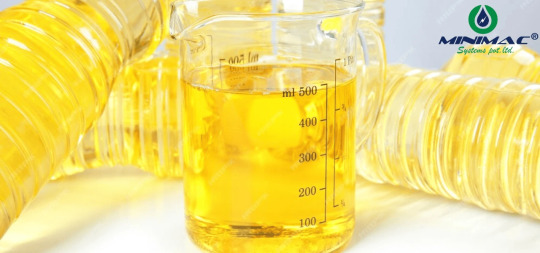
Importance of Viscosity in Lubrication
In lubrication, viscosity determines how effectively a lubricant can separate moving components, reducing friction, preventing wear, and minimizing energy loss. Using the wrong viscosity lubricant can lead to either inadequate protection (if too low) or increased drag and energy consumption (if too high).
For industrial machinery, oil and grease formulations are selected based on viscosity SI units and standardized measurement systems like ISO VG (Viscosity Grade) and SAE (Society of Automotive Engineers) viscosity grades.
Viscosity SI Units and Other Measurement Units
Viscosity is measured using several units depending on whether it is dynamic viscosity or kinematic viscosity.
Dynamic Viscosity (Absolute Viscosity) Units
SI Unit: Pascal-second (Pa·s) or milliPascal-second (mPa·s)
CGS Unit: Poise (P) or centipoise (cP), where 1 P = 0.1 Pa·s
Common Industrial Use: Centipoise (cP) is frequently used in lubrication industry applications.
Kinematic Viscosity Units
SI Unit: Square meter per second (m²/s)
CGS Unit: Stokes (St) or centistokes (cSt), where 1 St = 10⁻⁴ m²/s
Common Industrial Use: Centistokes (cSt) is the most widely used unit in industrial lubrication, with ISO VG ratings based on kinematic viscosity at 40°C.
Understanding Absolute Viscosity (Dynamic Viscosity)
Absolute viscosity, also known as dynamic viscosity, refers to a fluid’s resistance to shear stress. It measures the force required to move one layer of fluid over another.
Formula:
Where:
= dynamic viscosity (Pa·s or cP)
= applied force (N)
= area of the fluid layer (m²)
= velocity gradient (s⁻¹)
Dynamic viscosity is used to determine how a lubricant behaves under mechanical stress and is critical in applications involving gears, hydraulics, and compressors.
Understanding Kinematic Viscosity
Kinematic viscosity is the ratio of dynamic viscosity to the density of the fluid. It represents how fast a fluid flows under gravity.
Formula:
= kinematic viscosity (m²/s or cSt)
= dynamic viscosity (Pa·s or cP)
= density of the fluid (kg/m³)
Kinematic viscosity is widely used in industrial lubrication standards such as ISO VG ratings, which categorize lubricants based on their kinematic viscosity at 40°C
Viscosity vs. Kinematic Viscosity
While dynamic viscosity measures a fluid’s internal resistance to movement, kinematic viscosity considers both viscosity and fluid density. In lubrication, the kinematic viscosity-to-viscosity relationship helps in determining how a lubricant will behave under real-world operating conditions.
Coefficient of Viscosity Unit and Its Role
The coefficient of viscosity represents the relationship between shear stress and shear rate in a fluid. It is often synonymous with dynamic viscosity in Newtonian fluids. The coefficient of viscosity is crucial in industries where precise viscosity control is required for operations like metalworking, automotive lubrication, and hydraulic systems.
Viscosity Measurement Units and Techniques
Measuring viscosity requires specialized instruments that ensure accuracy in selecting the right lubricant.
Common Viscosity Measurement Techniques:
Capillary Viscometers (Ubbelohde, Ostwald) – Used for kinematic viscosity.
Rotational Viscometers (Brookfield Viscometer) – Measures dynamic viscosity.
Falling Ball Viscometer – Determines viscosity by measuring the falling speed of a ball through the fluid.
Redwood and Saybolt Viscometers – Used in petroleum industries.
Each method provides valuable insights into the viscosity behavior of lubricants under different conditions.
Conclusion
Understanding viscosity measurement units and their significance in lubrication is crucial for selecting the right lubricant. Absolute viscosity (dynamic viscosity) and kinematic viscosity serve different purposes but are interrelated. By using viscosity SI units like Pascal-seconds and centistokes, industries can ensure optimal lubrication performance, reduce wear, and enhance machinery longevity. For more information - click here
#frf#oil flushing#minimac systems#power#minimac#oil & gas#lube oil filter#hydraulic oil#contamination#hydraulic oil filter#oil filtration system#oil purification system#oil purification#oil purification machine#oil dehyration#oil dehydration systems#lvdh#coalescer separator#flushing#lube oil flushing#hydraulic oil flushing#chemical cleaning flushing#chemical flushing#oil filters#transformer oil#transformer oil cleaning#transformer oil filtration#oil and gas#power industry#turbine oilanalysis maintenance lubrication reliability contaminationcontrol oil powerplants oilfiltration rotatingequipment mechanical bre
0 notes
Text
Hướng Dẫn Chi Tiết Sử Dụng, Lập Trình Và So Sánh PLC Siemens S7-1200
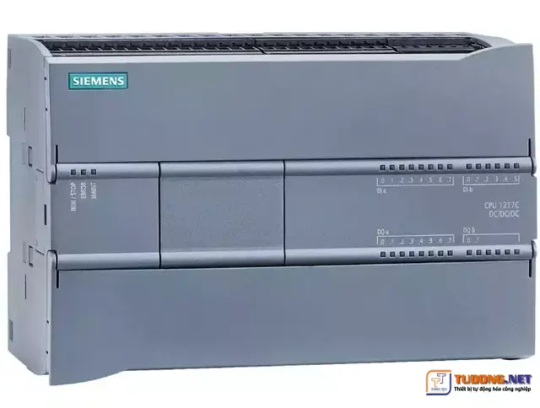
PLC SIEMENS S7-1200: Tổng Quan, Tính Năng, Hướng Dẫn Sử Dụng, So Sánh, Đánh Giá Thị Trường Và Ứng Dụng
Khám phá toàn diện PLC SIEMENS S7-1200 – từ tổng quan sản phẩm, tính năng nổi bật, hướng dẫn cài đặt, lập trình và đấu nối đến so sánh với các dòng PLC khác của Siemens và đối thủ cạnh tranh giúp bạn lựa chọn giải pháp tự động hóa phù hợp cho nhà máy và hệ thống của mình.
I. Tổng Quan Về PLC SIEMENS S7-1200

1.1 Giới Thiệu Chung PLC (Programmable Logic Controller) là bộ điều khiển lập trình được sử dụng phổ biến trong tự động hóa công nghiệp. Trong đó, dòng SIMATIC S7-1200 của Siemens ra đời năm 2009 nhằm thay thế dần S7-200, với thiết kế nhỏ gọn, hiệu suất cao và khả năng mở rộng linh hoạt. • Đặc điểm nổi bật: • Thiết kế dạng module cho phép mở rộng các I/O và module truyền thông. • Tích hợp cổng PROFINET hỗ trợ Ethernet và giao thức TCP/IP, giúp kết nối nhanh chóng với các thiết bị khác. • Hỗ trợ phần mềm TIA Portal – môi trường lập trình trực quan, tích hợp các công cụ cấu hình, lập trình, chẩn đoán và giám sát hệ thống. 1.2 Lịch Sử Và Sự Phát Triển Ban đầu ra mắt để khắc phục nhược điểm của dòng S7-200, S7-1200 đã nhanh chóng chiếm được cảm tình của các chuyên gia tự động hóa nhờ khả năng xử lý nhanh, độ tin cậy cao và chi phí đầu tư hợp lý. Qua các phiên bản nâng cấp, sản phẩm ngày càng được cải tiến về tính năng, bảo mật và hỗ trợ các giao thức truyền thông mới. 1.3 Các Dòng Sản Phẩm Thuộc Series S7-1200

Dòng PLC S7-1200 bao gồm nhiều biến thể để phù hợp với các yêu cầu ứng dụng đa dạng: • Standard CPUs: CPU 1211C, 1212C, 1214C, 1215C, 1217C. • Failsafe CPUs: Dành cho các ứng dụng đòi hỏi độ an toàn cao theo IEC 61508, ISO 13849-1. • SIPLUS CPUs: Biến thể SIPLUS được thiết kế đặc biệt cho môi trường khắc nghiệt, có khả năng chống bụi, ẩm, ăn mòn và nhiệt độ mở rộng.
II. Tính Năng Nổi Bật Của PLC SIEMENS S7-1200
2.1 Hiệu Suất Và Độ Tin Cậy • Vi xử lý mạnh mẽ: S7-1200 được trang bị vi xử lý ARM Cortex, đảm bảo khả năng tính toán nhanh và đáp ứng yêu cầu của các ứng dụng thời gian thực. • Độ bền cao: Thiết kế chuyên dụng cho môi trường công nghiệp, hoạt động ổn định trong điều kiện khắc nghiệt như nhiệt độ cao, rung động, và bụi bẩn. 2.2 Khả Năng Mở Rộng Và Tính Linh Hoạt • Thiết kế dạng module: Cho phép mở rộng I/O thông qua các board tín hiệu (Signal Board – SB) và các module mở rộng (I/O modules – SM, CM). • Hỗ trợ nhiều giao thức truyền thông: • PROFINET: Cổng giao tiếp tích hợp sẵn giúp kết nối với hệ thống mạng Ethernet và các thiết bị điều khiển từ xa. • RS232, RS485: Cho phép kết nối với các thiết bị ngoại vi khác khi cần mở rộng chức năng. • Phần mềm TIA Portal: Giao diện lập trình trực quan, hỗ trợ các ngôn ngữ lập trình như LAD, FBD và SCL giúp quá trình cấu hình, lập trình và bảo trì trở nên dễ dàng hơn.
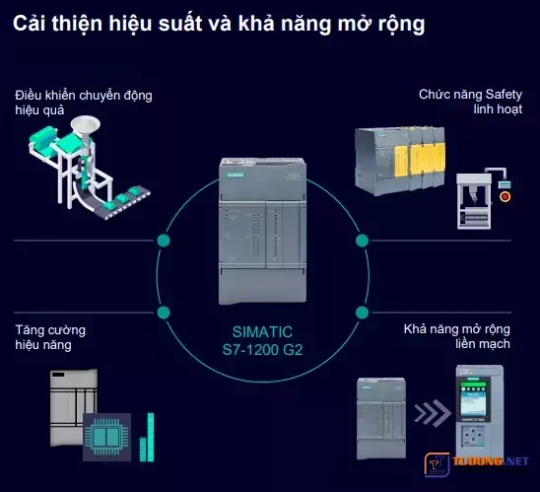
2.3 Bảo Mật Và An Toàn • Chức năng bảo vệ truy cập: Tất cả CPU đều hỗ trợ bảo vệ bằng mật khẩu và tính năng “know-how protection” giúp bảo vệ chương trình điều khiển khỏi truy cập trái phép. • Ứng dụng trong hệ thống an toàn: Các phiên bản Failsafe của S7-1200 được thiết kế để đáp ứng các yêu cầu an toàn theo tiêu chuẩn IEC 61508 và ISO 13849-1, đảm bảo hoạt động ổn định trong các ứng dụng đòi hỏi độ an toàn cao.

2.4 Tính Năng Lập Trình Và Giao Diện Người Dùng • TIA Portal: Môi trường tích hợp giúp lập trình, cấu hình phần cứng, thiết kế giao diện HMI và giám sát hệ thống tự động hóa. • Các ngôn ngữ lập trình: • LAD (Ladder Diagram): Hình thức lập trình truyền thống, trực quan với sơ đồ điện. • FBD (Function Block Diagram): Cho phép lập trình bằng cách kết nối các khối chức năng. • SCL (Structured Control Language): Ngôn ngữ lập trình cấp cao tương tự Pascal, hữu ích trong các ứng dụng phức tạp.
III. Hướng Dẫn Sử Dụng Và Lập Trình PLC SIEMENS S7-1200
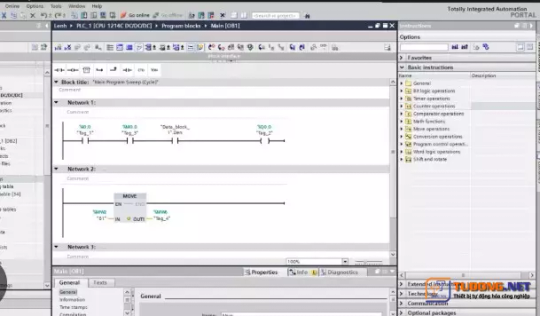
3.1 Cài Đặt Phần Cứng Và Đấu Nối 3.1.1 Cấu Tạo Cơ Bản Của PLC S7-1200 • CPU: Bộ não của PLC, bao gồm CPU tiêu chuẩn, Failsafe và SIPLUS. • Nguồn cấp: PLC S7-1200 có thể hoạt động với nguồn AC hoặc DC tùy thuộc vào biến thể (AC/DC/RLY, DC/DC/DC). • I/O tích hợp: Sản phẩm tích hợp sẵn các chân vào/ra (DI, DO, AI, AO) và hỗ trợ mở rộng qua các module SB, SM, CM.

3.1.2 Hướng Dẫn Đấu Nối • Đấu nối nguồn: • Với nguồn DC 24V: Nối cực dương (+) của nguồn 24V vào chân L+ và cực âm (–) vào chân M của CPU. • Với nguồn AC: Xác định kỹ yêu cầu của CPU (AC/DC) và đấu nối 2 chân của nguồn AC vào các chân L+ và N. • Đấu nối tín hiệu vào/ra: • Digital Inputs/Outputs: Kết nối các cảm biến, công tắc, động cơ hoặc van qua các chân DI/DO tích hợp. • Analog Inputs/Outputs: Dùng để đo điện áp, dòng điện, nhiệt độ,… qua các module AI/AO. Lưu ý: Việc đấu nối cần tuân thủ sơ đồ mạch của từng loại CPU và đảm bảo an toàn điện. Hãy tham khảo tài liệu kỹ thuật của Siemens để tránh nhầm lẫn giữa các chân nối. 3.2 Hướng Dẫn Cài Đặt Phần Mềm Lập Trình 3.2.1 Cài Đặt TIA Portal TIA Portal là phần mềm tích hợp của Siemens hỗ trợ lập trình cho PLC, HMI và các thiết bị khác. Các bước cài đặt cơ bản bao gồm: 1. Tải và cài đặt TIA Portal phiên bản phù hợp (thường là phiên bản từ TIA Portal V11 trở lên). 2. Kết nối máy tính với PLC qua cáp Ethernet hoặc RS232/RS485. 3. Cấu hình địa chỉ IP của PLC (ví dụ: 192.168.138.36) sao cho khớp với máy tính.

3.2.2 Quy Trình Lập Trình Cơ Bản • Tạo dự án mới: Mở TIA Portal, chọn “Create new project”, đặt tên và lưu đường dẫn dự án. • Cấu hình thiết bị: Thêm thiết bị PLC bằng cách chọn dòng S7-1200 và loại CPU (ví dụ: CPU 1214C DC/DC/DC). • Lập trình OB1: OB1 là chương trình chính, nơi viết các lệnh điều khiển bằng ngôn ngữ lập trình như LAD, FBD hay SCL. • Download chương trình: Sau khi hoàn thành lập trình, kết nối PLC với máy tính và nạp chương trình vào PLC. • Giám sát và chẩn đoán: Sử dụng TIA Portal để theo dõi trạng thái chạy, kiểm tra lỗi và điều chỉnh chương trình nếu cần. 3.3 Ví Dụ Chương Trình Cơ Bản 3.3.1 Chương Trình Điều Khiển Đèn • Mục tiêu: Khi nhấn công tắc (DI), đèn (DO) sẽ sáng. • Lập trình bằng LAD: • Sử dụng lệnh “Tiếp điểm thường hở” cho DI. • Kết hợp với lệnh “OUT” để điều khiển đèn. • Download chương trình và kiểm tra trên thực tế.
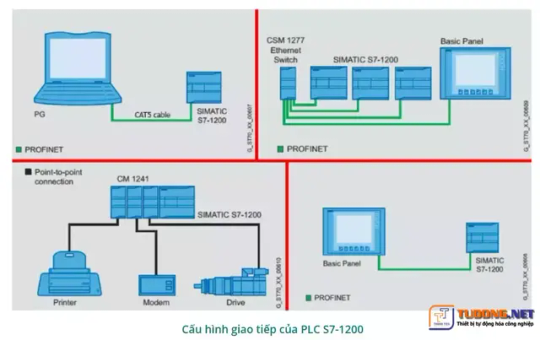
3.3.2 Chương Trình Sử Dụng Timer Và Counter • Timer: Tạo chương trình trễ định thời để điều khiển các tác vụ theo chu kỳ nhất định. • Counter: Đếm số lần nhấn công tắc để kích hoạt một hành động khi đạt đến giá trị giới hạn. Ví dụ: Bật một động cơ sau 10 lần nhấn công tắc. • Sử dụng lệnh CTU (Counter Up) và kết hợp với lệnh so sánh. 3.4 Hướng Dẫn Lập Trình Nâng Cao Ngoài các chương trình cơ bản, TIA Portal còn hỗ trợ lập trình các hàm phức tạp như: • Hàm toán học: Thực hiện phép cộng, trừ, nhân, chia… • Hàm logic: AND, OR, XOR, NOT… • Hàm chuyển đổi dữ liệu: CONV, ROUND, TRUNC,… • Hàm chốt (Flip-Flop): SR, RS để tạo mạch nhớ trạng thái. Việc sử dụng các hàm này giúp xây dựng các chương trình điều khiển phức tạp cho các dây chuyền sản xuất tự động hóa lớn.
IV. So Sánh PLC SIEMENS S7-1200 Với Các Sản Phẩm Khác
4.1 So Sánh Với Các Dòng PLC Khác Của Siemens

Siemens cung cấp nhiều dòng PLC khác nhau, trong đó S7-1200, S7-300 và S7-1500 là các dòng phổ biến. Dưới đây là bảng so sánh chi tiết: Tiêu chí S7-1200 S7-300 S7-1500 Thiết kế Nhỏ gọn, tích hợp sẵn I/O; dạng module mở rộng Trung cấp, thích hợp cho hệ thống lớn Hiện đại, hiệu suất cao, mở rộng linh hoạt Hiệu suất Phù hợp với ứng dụng nhỏ và trung bình Xử lý nhanh hơn S7-1200 trong các ứng dụng vừa Xử lý lệnh rất nhanh, phù hợp cho các hệ thống phức tạp Khả năng mở rộng Dễ dàng mở rộng qua các module SB, SM, CM Mở rộng được qua các module mở rộng chuyên dụng Hỗ trợ mở rộng đa dạng với nhiều module và giao thức truyền thông Giao tiếp Tích hợp PROFINET, Ethernet; hỗ trợ RS232/RS485 Hỗ trợ Profibus, Ethernet; kết nối MPI Tích hợp Ethernet, OPC, Web server, và nhiều giao thức hiện đại Phần mềm lập trình TIA Portal (lập trình LAD, FBD, SCL) Step7 (lập trình LAD, STL, FBD, SCL) TIA Portal; giao diện trực quan, tích hợp HMI Giá thành Giá thành cạnh tranh cho ứng dụng nhỏ và vừa Giá cao hơn so với S7-1200 Đầu tư ban đầu cao, nhưng phù hợp cho quy mô sản xuất lớn 4.2 So Sánh Với PLC Của Các Hãng Khác

Ngoài Siemens, trên thị trường còn có các hãng PLC như Omron, Mitsubishi, Schneider… • Omron: • Ưu điểm: Thiết kế thân thiện, dễ lập trình, tích hợp nhiều tính năng bảo vệ. • Nhược điểm: Giá thành thường cao hơn và khả năng mở rộng ít linh hoạt so với S7-1200. • Mitsubishi: • Ưu điểm: Hiệu suất cao, phù hợp với các ứng dụng tốc độ nhanh. • Nhược điểm: Giao diện lập trình không trực quan bằng TIA Portal của Siemens. • Schneider Electric: • Ưu điểm: Độ tin cậy cao, tích hợp nhiều chức năng tự động hóa. • Nhược điểm: Chi phí đầu tư ban đầu thường cao và hỗ trợ kỹ thuật có thể hạn chế tại một số thị trường.

Bảng tóm tắt so sánh chung: Hãng sản xuất Ưu điểm Nhược điểm Siemens TIA Portal trực quan, khả năng mở rộng linh hoạt, bảo mật cao Giá thành cạnh tranh ở dòng S7-1200, nhưng các dòng cao cấp (S7-1500) có chi phí đầu tư cao Omron Thiết kế dễ sử dụng, lập trình đơn giản Giá thành cao hơn, khả năng mở rộng hạn chế Mitsubishi Hiệu suất xử lý nhanh, phù hợp với ứng dụng tốc độ cao Giao diện lập trình không được đánh giá cao như Siemens Schneider Độ tin cậy cao, tích hợp nhiều chức năng tự động hóa Chi phí ban đầu cao, hệ thống phần mềm phức tạp
V. Đánh Giá Thị Trường Và Ứng Dụng Thực Tế
5.1 Thị Phần Và Xu Hướng Phát Triển • Thị trường PLC toàn cầu: PLC là thành phần cốt lõi của tự động hóa công nghiệp, và Siemens luôn dẫn đầu nhờ chất lượng sản phẩm, độ tin cậy và khả năng tích hợp. Dòng S7-1200 đặc biệt được ưa chuộng tại các nước đang phát triển như Việt Nam nhờ giá thành hợp lý và dễ dàng bảo trì. • Xu hướng ứng dụng: • Sự chuyển đổi số trong các nhà máy sản xuất và ngành công nghiệp 4.0 tạo ra nhu cầu tăng cao đối với các hệ thống điều khiển tự động. • Tích hợp IoT và M2M (machine-to-machine) qua cổng Ethernet của S7-1200 giúp giám sát từ xa và tối ưu hóa quy trình sản xuất. 5.2 Ứng Dụng Thực Tế

PLC Siemens S7-1200 được ứng dụng rộng rãi trong nhiều lĩnh vực: • Ngành sản xuất: • Điều khiển dây chuyền sản xuất, máy đóng gói, máy chế biến thực phẩm, sản xuất điện tử,… • Tích hợp với hệ thống SCADA và HMI giúp theo dõi, giám sát và điều chỉnh quy trình sản xuất theo thời gian thực. • Ngành xử lý nước và năng lượng: • Quản lý hệ thống cấp, thoát nước, điều khiển bơm nước, và hệ thống giám sát năng lượng. • Ứng dụng trong tòa nhà thông minh: • Điều khiển hệ thống chiếu sáng, điều hòa không khí, hệ thống an ninh, và tự động hóa các quy trình vận hành của tòa nhà. • Ngành dược phẩm và thực phẩm: • Đảm bảo quá trình sản xuất đạt chuẩn an toàn, kiểm soát nhiệt độ, thời gian và các thông số quan trọng khác. 5.3 Phản Hồi Từ Người Dùng Và Đối Tác • Đánh giá từ chuyên gia: Các kỹ sư tự động hóa đánh giá cao S7-1200 vì khả năng mở rộng và tính linh hoạt khi triển khai trên nhiều ứng dụng khác nhau. • Phản hồi từ người dùng: Người dùng nhấn mạnh tính ổn định, dễ lập trình và chi phí bảo trì thấp, góp phần giảm thiểu thời gian chết của dây chuyền sản xuất. • Đối tác và đại lý: Nhiều nhà phân phối và đối tác của Siemens tại Việt Nam cam kết cung cấp sản phẩm chính hãng, hỗ trợ kỹ thuật chuyên sâu và các dịch vụ sau bán hàng tốt.
VI. Câu Hỏi Thường Gặp (FAQ)
6.1 PLC S7-1200 là gì? PLC S7-1200 là bộ điều khiển lập trình của Siemens, được thiết kế dạng module nhỏ gọn, dễ dàng mở rộng I/O, tích hợp cổng giao tiếp PROFINET và hỗ trợ lập trình qua TIA Portal. Nó được ứng dụng rộng rãi trong các hệ thống tự động hóa công nghiệp và dây chuyền sản xuất nhỏ đến vừa. 6.2 Những ứng dụng tiêu biểu của PLC S7-1200 là gì? PLC S7-1200 được sử dụng trong điều khiển dây chuyền sản xuất, máy đóng gói, hệ thống xử lý nước, tòa nhà thông minh, ngành thực phẩm – đồ uống, và các hệ thống tự động hóa nhỏ khác. Nó cũng được áp dụng trong các ứng dụng kiểm soát năng lượng và tiết kiệm điện năng. 6.3 S7-1200 có thể mở rộng như thế nào? PLC S7-1200 cho phép mở rộng I/O thông qua các module tín hiệu số (Digital Modules), module tín hiệu tương tự (Analog Modules) và module truyền thông (Communication Modules). Các board mở rộng (SB, SM, CM) giúp tăng số lượng chân kết nối và tích hợp các chức năng bổ sung. 6.4 Phần mềm lập trình nào được sử dụng cho S7-1200? Phần mềm lập trình chính của S7-1200 là TIA Portal của Siemens, hỗ trợ lập trình bằng các ngôn ngữ LAD, FBD và SCL. TIA Portal tích hợp đầy đủ các công cụ cấu hình, lập trình, giám sát và chẩn đoán hệ thống. 6.5 PLC S7-1200 có phù hợp cho ứng dụng tự động hóa quy mô lớn không? Mặc dù S7-1200 thường được ứng dụng cho các hệ thống nhỏ đến vừa, nhưng nhờ khả năng mở rộng linh hoạt và tích hợp giao thức truyền thông hiện đại, nó vẫn có thể được sử dụng trong một số ứng dụng quy mô trung bình. Đối với hệ thống rất lớn, các dòng S7-300, S7-1500 hoặc S7-400 của Siemens thường là lựa chọn ưu tiên. 6.6 So sánh giữa S7-1200 và các PLC của các hãng khác, tại sao nên chọn Siemens? Siemens là thương hiệu hàng đầu với hệ sinh thái tự động hóa toàn diện, từ phần cứng đến phần mềm. TIA Portal của Siemens có giao diện trực quan, khả năng mở rộng cao và tính bảo mật tốt, giúp giảm thiểu thời gian bảo trì và tăng hiệu quả sản xuất. Các hãng khác như Omron, Mitsubishi hay Schneider cũng có những ưu điểm riêng, nhưng Siemens S7-1200 nổi trội ở tính linh hoạt và khả năng tích hợp trong các hệ thống hiện đại.
VII. Kết Luận & Đại lý bán PLC SIEMENS
7.1 Tổng Kết PLC SIEMENS S7-1200 không chỉ là một sản phẩm điều khiển đơn giản mà còn là giải pháp toàn diện cho các ứng dụng tự động hóa công nghiệp hiện đại. Với thiết kế nhỏ gọn, khả năng mở rộng linh hoạt, hỗ trợ giao tiếp đa dạng và phần mềm lập trình TIA Portal trực quan, S7-1200 đáp ứng được nhu cầu của các nhà máy sản xuất, hệ thống tòa nhà thông minh và nhiều ứng dụng khác. 7.2 Lời Khuyên Cho Người Mua Nếu bạn là kỹ sư, quản lý nhà máy hoặc đơn vị đang tìm kiếm giải pháp tự động hóa hiệu quả với chi phí hợp lý, hãy cân nhắc đến PLC Siemens S7-1200. Việc lựa chọn đúng dòng PLC không chỉ giúp tối ưu hóa quy trình sản xuất mà còn nâng cao hiệu suất và giảm thiểu thời gian chết của hệ thống. 7.3 Hỗ Trợ Và Tư Vấn Kỹ Thuật Để được tư vấn chi tiết và hỗ trợ kỹ thuật, bạn có thể liên hệ với các đại lý chính hãng PLCSIEMENS.VN hoặc trung tâm dịch vụ của Siemens. Ngoài ra, có rất nhiều tài liệu hướng dẫn được cập nhật thường xuyên nhằm giúp người dùng làm quen với việc cài đặt, lập trình và vận hành PLC S7-1200. • Liên hệ với Công Ty Thành Tiến qua số Hotline: 0888 789 688 hoặc Email: [email protected] để được tư vấn và báo giá sản phẩm chính hãng. • Truy cập website https://plcsiemens.vn/ để biết thêm thông tin chi tiết và các giải pháp tự động hóa mới nhất từ Siemens. 7.4 Danh mục PLC S7-1200 và Các modul mổ rộng xem chi tiết ở đây
VIII. Phần Mở Rộng & Các Ứng Dụng Thêm
8.1 Ứng Dụng Trong Ngành Năng Lượng • Giám sát năng lượng: Sử dụng module đo năng lượng tích hợp (ví dụ: SIMATIC Energy Manager) để giám sát và tối ưu hóa tiêu thụ năng lượng của máy móc, qua đó giúp tiết kiệm điện năng và giảm chi phí vận hành. • Quản lý tải: Các chương trình điều khiển tích hợp chức năng quản lý tải cao điểm giúp ngăn chặn tình trạng quá tải, đảm bảo an toàn cho toàn bộ hệ thống. 8.2 Ứng Dụng Trong Nhà Máy Và Dây Chuyền Sản Xuất

• Điều khiển dây chuyền tự động: PLC S7-1200 được tích hợp với hệ thống SCADA và HMI, giúp giám sát từ xa và điều chỉnh quy trình sản xuất theo thời gian thực. • Quy trình sản xuất liên tục: Khả năng xử lý lệnh nhanh và lập trình logic phức tạp giúp các dây chuyền sản xuất chạy ổn định, giảm thời gian dừng máy. 8.3 Ứng Dụng Trong Tòa Nhà Thông Minh • Hệ thống chiếu sáng tự động: Sử dụng PLC để điều khiển đèn chiếu sáng, cảm biến chuyển động và điều chỉnh mức ánh sáng theo thời gian trong ngày. • Điều hòa không khí và an ninh: Kết nối PLC với hệ thống HVAC và các thiết bị an ninh giúp tối ưu hóa môi trường làm việc và tăng cường an toàn. 8.4 Ứng Dụng Trong Ngành Thực Phẩm – Đồ Uống • Quy trình đóng gói và chế biến: Đảm bảo chất lượng sản phẩm bằng cách điều khiển chính xác thời gian, nhiệt độ và tốc độ của các thiết bị đóng gói. • Kiểm soát chất lượng: Tích hợp các cảm biến và module đo lường giúp giám sát quá trình sản xuất, từ đó đảm bảo sản phẩm đạt tiêu chuẩn an toàn thực phẩm.
IX.
Read the full article
0 notes
Video
High-ISO Autumn night by Pascal Volk
#Europe#Germany#Berlin#Berlin Mitte#Mitte#Park am Fernsehturm#Nacht#Night#Noche#Baum#árbol#Tree#Leaves#Blätter#Hojas#Herbstfarben#Herbstlaub#Autumn leaf color#Natur#nature#naturaleza#Pflanze#plant#planta#Herbst#fall#autumn#otoño#Canon EOS 5D Mark IV#5DMkIV
0 notes
Text

The Pond
I took this photo on an overcast day while searching for frogs around this pond. Although I could hear them jumping into the water whenever I was getting too close, I never did see a single one.
I was attracted by the layering of the reeds in the foreground, the brown seed heads, the reflections of the clouds and the reflection of the trees on the pond. I focused the image so the nearest reeds were blurred in order to emphasize the depth of the layering. I composed the frame so that the brown seed heads cut diagonals across the vertical lines of reeds.
The image was taken during an artist networking event organized by the Conseil des Arts Prescott-Russell Art Council, held at Verger Villeneuve and Blueberry Farm in Saint-Pascal-Baylon, ON, Canada.
Processed with Affinity Photo v2.
Camera: Pentax K-3
Lens: smc Pentax DA 18-135mm ED AL [IF] DC WR
60mm / ƒ/7.1 / 1/250s / ISO 400
Taken: July 16, 2024
#photographer on tumblr#original photographers#original photography#landscape photography#pond#cloudy#reeds#canada#ontario#where I live#summer#July#2024#pentax#pentaxian#pentax k3#Affinity Photo
9 notes
·
View notes
Note
The Mavs are battle tested. Against a veteran team like the clippers, a young upstart team like OKC, and the best defense in the league with the Wolves. JKidd has been one of the smartest guys in the NBA dating back to when he won a chip with the Mavs as a player and even just being a star on the Nets as a top 5 PG in the league and he's shaped Luka and Kyrie into the most dangerous backcourt duo since prime Splash Brothers. The wolves in particular hit Luka with a different type of defense every game in that series. Drop coverage, Covering from 94ft, Zone defense. None of it worked against Luka or Kyrie. Luka's combination of insane iso play and pin point passes makes it so difficult to scheme against him. Feels like he guarantees a nearly open shot every possession. And with Lively or Gafford as a lob threat, that's even harder to guard. You gotta pick your poison at that point. Do you want a stepback from Luka? An impossible layup from Kai? A corner 3 from Washington? An alley oop from Lively or Gafford? We talk about Boston having an option at every position but let's not act like that's not also the case with Dallas.
J&J haven't had to go toe to toe for a full series against a legit superstar duo or even just one superstar in this playoff run. The closest they really got was like... Pascal Siakam after Hali got hurt and even as a raptors fan who loved that 2019 team immensely that's not quite comparable to a Jimmy Butler or even a Tyrese Haliburton.
I’ve only ever followed the WNBA and only started watching the NBA this season so i’m still tryna catch up on stuff… why does everyone hate the Boston Celtics 😭
what a QUESTION!
me? i’m a hating ass bitch
well first of all celtics fans are just wrong. audacity to call themselves a dynasty when their last ring was in 2008. both the other franchises that call themselves dynasties (lakers and warriors) have both won consistently in the past and won a ring in the last four years.
also the majority of celtics fans (not nivi and not my anon) are some of the most awful fucking ppl ever. they are racist, sexist, homophobic, all the shit. FUCK celtics fans bro
17 notes
·
View notes
Photo

New Post has been published on https://classic.technology/de-acorn-electron/
De Acorn Electron
https://i0.wp.com/classic.technology/wp-content/uploads/2021/05/DeAcornElectron.jpg?fit=500%2C707&ssl=1
0 notes
Photo



Y’a l’tour de l’île 42 milles Pu très tranquille Pentax K1000, Kodak Tx400, 1600 ISO.
#pentax#pentax k1000#pascal audet#film#film photography#35mm film#film is not dead#kodak#Kodak 400TX#1600 ISO#Black and White#landscape#horse
7 notes
·
View notes
Photo
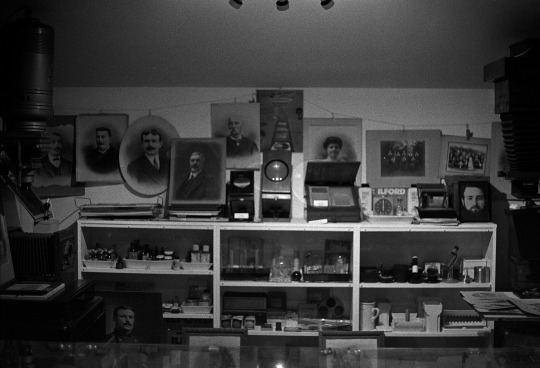





Visite du Musée de la Photo de Beautiran, en Janvier 2022 avec Michaël & Matthieu. Merci beaucoup à Pascal pour son temps & toutes ses anecdotes sur ces appareils chargés d’Histoire que nous avons adoré découvrir ! Un article a retrouver dans le Grainzilla n°8 ! Janvier 2022. Ilford HP5 400 iso.
2 notes
·
View notes
Text
To my knowledge, this is a list of all of the game-only programs in the Tron: Legacy era video games (Tron: Evolution, Tron: Evolution Battle Grids, Tron: Evolution DS, and Tron: Evolution PSP).
Programs that you play against or are mentioned by name:
Aetos Argus Aristo Axelia Axiom Ayrton Baxter Bevan Blaze Bytor Callstack Cardinal Chiron Crash Deacon Debian Dell* Demas Dorak Euler Falda Flash Fulcrum Galina* Galois Ghassan Glider Hamilton Heap Hiro Hue Ismena Jack* Johnson Kernel Lazarus Nala* Necker Nestor Nim Panos Pappus Pascal* Pythia Radix Skordev Slave Soroban Talbot Tarski Tasck Tasram Theano Theseus Thiele Ulcmar Varignon Webster Weema Yosan Zarek
Programs with plot importance, but only show up in one game:
Blaze Bosh Calchas (ISO) Doran Kalev Odion Tenaes
Game-only programs that are very important or player characters:
Abraxas (virus) Anon Beta Gibson (ISO) Jalen (ISO) Radia (ISO) (Called Ophelia in Tron: Betrayal)
*These names are audio-only, so the spelling may be different than what I've written here.
#Tron#Tron: Evolution#Tron: Evolution Battle Grids#Tron: Evolution DS#Tron: Evolution PSP#Tron Evolution#Tron Evolution Battle Grids#Tron Evolution DS#Tron Evolution PSP
47 notes
·
View notes
Text
ComProg History YOU SHOULD KNOW!!!


1843 Ada Lovelace is credited as being the first person to describe or write a computer program.
In 1843, she described an algorithm to compute Bernoulli numbers using the Analytical Engine.
1889 The Hollerith tabulating machine was invented by Herman Hollerith in 1889, allowing for data to be programmatically counted and tabulated.
1956 One of the first programming languages, FORTRAN, was introduced to the public on October 15, 1956. It was developed by John Backus and others at IBM.
1958 The second-oldest programming language, LISP was developed by John McCarthy and was first used in 1958.
1959 COBOL started being developed in 1959 by Grace Hopper and Bob Bemer.
1964 The original BASIC programming language was developed by John Kemeny, Mary Keller, and Thomas Kurtz, and was introduced to the public on May 1, 1964.
1965 Simula is considered the first ever object-oriented programming language, developed around 1965 by Ole-Johan Dahl and Kristen Nygaard.
1966 Martin Richards developed the BCPL programming language in 1966, which became popular due to its portability.
1966 The MUMPS programming language was developed by Neil Pappalardo at Massachusetts General Hospital in 1966.
1967 Known for its graphics capabilities, Logo was created by Seymour Paper in 1967.
1971 Pascal was developed in 1971 by Niklaus Wirth.
1972 Dennis Ritchie and Brian Kernighan developed the C programming language at Bell Labs in 1972.
1972 The Prolog programming language was developed by Alain Colmerauer and colleagues in 1972 at the University of Marseilles.
1972 Smalltalk was the second ever object-oriented programming language and the first true IDE, developed by Alan Kay and others at Xerox PARC in 1972.
1974 SQL is a database programming language and was developed by Edgar Codd in 1974 and is still important in the programming language world.
1975 A variation of LISP, the Scheme programming language was created in 1975 by Guy Steele and Gerry Sussman at MIT's Artificial Intelligence lab.
1975 The Altair BASIC programming language was developed by Bill Gates, Paul Allen, and Monte Davidoff, and was made available for use on January 2, 1975. It was used to create programs for Altair computers.
1979 Development of the C++ programming language was started in 1979 by Bjarne Stroustrup. Originally called "C with classes," C++ is one of the most widelyused programming languages.
1979 Oracle released the first commercial version of SQL in 1979.
1979 The Department of Defense developed the Ada programming language, originally named DoD-1, and named it after Ada Lovelace in May 1979.
1984 FoxPro is a programming language for developing database applications and was released by Fox Software in 1984.
1984 Cleve Moler started developing the MATLAB programming language in the late 1970s, and it was released to the public, with the MATLAB software package, in 1984.
1987 The open source programming language Perl that was developed by Larry Wall was introduced in 1987. It is commonly used in creating CGI scripts and programming web applications.
1988 Developed in the mid-1980s by Brad Cox and Tom Love, the Objective-C programming language was officially licensed by NeXT in 1988.
1990 Tim Berners-Lee developed the HTML markup language in 1990. HTML is one of the most popular and widely-used programming languages in the world.
1990 Haskell, a general-purpose programming language, was introduced in 1990.
1990 Engineers at Apple developed the Dylan programming language in the early 1990s. Dylan was designed to resemble the syntax of the ALGOL programming language.
1991 Development of Python was started in 1989 by Guido van Rossum and released to the public in 1991.
1991 Visual Basic was developed by Alan Cooper and released in May 1991.
1993 Lua was created in 1993 by engineers at the Pontifical Catholic University of Rio De Janeiro, Brazil.
1993 R is a programming language created by Robert Gentleman and Ross Ihaka and introduced in 1993.
1994 The concept of CSS was started by Håkon Wium Lie in 1994. W3C introduced the specification for CSS in 1996.
1995 Java was developed by James Gosling and other developers at Sun Microsystems, and was first introduced to the public in 1995.
1995 The object-oriented programming language Ruby developed by Yukihiro Matsumoto was first released in 1995.
1995 The experimental, multi-paradigm Curry programming language was introduced by Michael Hanus, Herbert Kuchen, and Juan Jose Moreno-Navarro in 1995.
1995 Racket is a general purpose programming language developed by Matthias Felleisen in 1995.
1995 A server-side interpreted scripting language, PHP was developed by Rasmus Lerdorf starting in 1994 and released on June 8, 1995.
1995 Originally named LiveScript when released in November 1995, JavaScript was developed by Brendan Eich and renamed as such in December 1995.
1996 Introduced in 1996, OCaml is an object-oriented version of the Caml programming language.
1998 XML is a markup language, with the specification for XML being developed by W3C and recommended on February 10, 1998.
1999 Development of the D programming language started in December 1999. D is a higher level language compared to C++.
2000 Based on C++ and Java, the C# programming language was developed by Microsoft and introduced in June 2000. C# became an ISO standard in 2003.
2003 The object-oriented programming language Scala was introduced in 2003.
2005 Don Syme developed the F# programming language and Microsoft first introduced it in 2005.
2007 The Go programming language was developed at Google starting in 2007. It was completed and introduced to the public in 2009.
2007 Rich Hickey developed the Clojure programming language and released the first version in 2007.
2008 Introduced in 2008, Nim is a programming language used to develop software requiring strict limits on how system memory is used.
2008 The object-oriented programming language Reia was introduced in 2008.
2010 The multi-paradigm CoffeeScript programming language, capable of being compiled into JavaScript, was officially released in 2010.
2011 Google developed the open source web-based Dart programming language, introducing it to the public in October 2011.
2012 Julia was developed by Jeff Bezanson, Alan Edelman, Stefan Karpinski, and Viral B. Shah and released in 2012. It is a high-level programming language used for scientific computing.
2014 Babel is a general-purpose programming language developed in 2014 and used to create programs for conserving battery life and system resources on devices.
2014 Created by Apple and released on June 2, 2014, the Swift programming language helps create programs and apps for iOS, macOS, the Apple Watch, and AppleTV.
2015 Graydon Hoare started development of the Rust programming language around 2010. After contributions from hundreds of people, it was officially released as version 1.0.0 alpha by Mozilla research on January 9, 2015.
#programming#programmer humor#now i know#now i want to cry#now i want more#ada lovelace#html css#html5 css3#html help#html code#programming history#history#codes#coding#debugging#historic preservation
7 notes
·
View notes